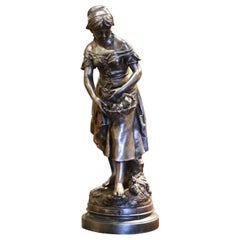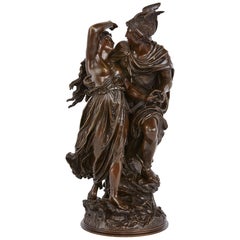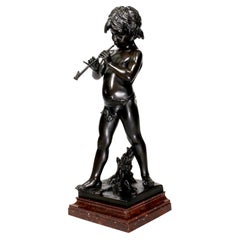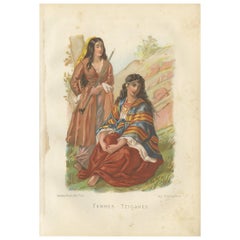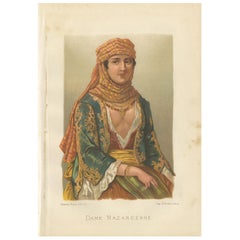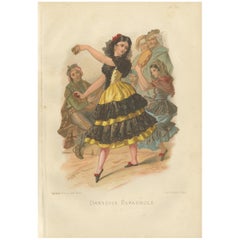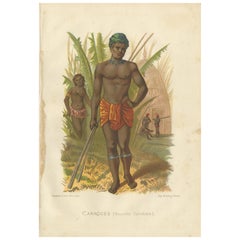L Gregoire
to
29
56
15
58
43
10
3
2
2
2
1
1
1
1
1
1
9
1
1
1
Sort By
19th Century Clock Garniture by L. Gregoire
By L. Gregoire 1
Located in Brighton, Sussex
A very impressive and striking French 19th century bronze clock garniture by L. Gregoire. Having
Category
Antique 1860s French Mantel Clocks
Materials
Bronze
Important Bronze sculpture “The Letter” by J-L. Grégoire – Late 19th century
By Emile Gregoire 1
Located in HÉRIC, FR
and poetry, this work is finely carved and signed on its base "L. Grégoire" and "Société des bronzes
Category
Antique Late 19th Century French Figurative Sculptures
Materials
Bronze
$4,211
H 25.2 in W 8.27 in D 5.12 in
19th Century French Spelter Female Statue with Bird Nest "Le Nid by L. Gregoire”
By Jean Louis Grégoire
Located in Dallas, TX
statue bears a plaque on the front which reads "Le Nid par L. Gregoire". The sweet sculpture is in
Category
Antique Mid-19th Century French Neoclassical Figurative Sculptures
Materials
Spelter
$1,600
H 24.25 in Dm 8 in
Patinated Bronze Antique Sculptural Group of Andromeda and Perseus by Grégoire
By L. Gregoire 1
Located in London, GB
length mythological figures, the pair are set on naturalistic circular base that is signed 'L. Grégoire
Category
Antique 19th Century French Classical Greek Figurative Sculptures
Materials
Bronze
$13,088
H 20.48 in W 10.63 in D 8.27 in
After Jean Louis Grégoire Spelter Figure "Boy Playing Pipe"
By Jean Louis Grégoire
Located in Los Angeles, CA
, in a brown patina. Raised on a Rouge Royal marble base. Signed: L. Gregoire and bearing the foundry
Category
Antique Early 1900s French Folk Art Figurative Sculptures
Materials
Marble, Spelter
$4,685 Sale Price
27% Off
H 22.25 in W 9 in D 7.38 in
Antique Print of Gypsy Women by Grégoire, '1883'
Located in Langweer, NL
originates from 'Géographie générale Physique, Politique et Économique' by L. Grégoire. Published 1883.
Category
Antique Late 19th Century Prints
Materials
Paper
$144 Sale Price
20% Off
H 10.83 in W 7.49 in D 0.02 in
Antique Print of a Nazarene Woman by Grégoire, 1883
Located in Langweer, NL
originates from 'Géographie générale Physique, Politique et Économique' by L. Grégoire. Published, 1883.
Category
Antique Late 19th Century Prints
Materials
Paper
$96 Sale Price
20% Off
H 10.83 in W 7.49 in D 0.02 in
Antique Print of a Spanish Dancer by Grégoire, 1883
Located in Langweer, NL
originates from 'Géographie générale Physique, Politique et Économique' by L. Grégoire. Published, 1883.
Category
Antique Late 19th Century Prints
Materials
Paper
$144 Sale Price
20% Off
H 10.83 in W 7.49 in D 0.02 in
Antique Print of a Kanak Man by Grégoire, 1883
Located in Langweer, NL
Caledonia. This print originates from 'Géographie générale Physique, Politique et Économique' by L. Grégoire
Category
Antique Late 19th Century French Prints
Materials
Paper
Antique Print of the City of Rouen by Grégoire '1883'
Located in Langweer, NL
originates from 'Géographie générale Physique, Politique et Économique' by L. Grégoire. Published 1883.
Category
Antique Late 19th Century Prints
Materials
Paper
$96 Sale Price
20% Off
H 7.49 in W 10.83 in D 0.02 in
Antique Print of the City of Berlin by Grégoire '1883'
Located in Langweer, NL
originates from 'Géographie générale Physique, Politique et Économique' by L. Grégoire. Published 1883.
Category
Antique Late 19th Century Prints
Materials
Paper
$96 Sale Price
20% Off
H 7.49 in W 10.83 in D 0.02 in
Antique Print of the City of Brest by Grégoire '1883'
Located in Langweer, NL
originates from 'Géographie générale Physique, Politique et Économique' by L. Grégoire. Published 1883.
Category
Antique Late 19th Century Prints
Materials
Paper
$96 Sale Price
20% Off
H 7.49 in W 10.83 in D 0.02 in
Antique Print of the City of Vienne by Grégoire '1883'
Located in Langweer, NL
originates from 'Géographie générale Physique, Politique et Économique' by L. Grégoire. Published 1883.
Category
Antique Late 19th Century Prints
Materials
Paper
$96 Sale Price
20% Off
H 7.49 in W 10.83 in D 0.02 in
Antique Print of the City of Damas by Grégoire '1883'
Located in Langweer, NL
originates from 'Géographie générale Physique, Politique et Économique' by L. Grégoire. Published 1883.
Category
Antique Late 19th Century Prints
Materials
Paper
$96 Sale Price
20% Off
H 7.49 in W 10.83 in D 0.02 in
Antique Print of the City of Naples by Grégoire, 1883
Located in Langweer, NL
originates from 'Géographie générale Physique, Politique et Économique' by L. Grégoire. Published 1883.
Category
Antique Late 19th Century Prints
Materials
Paper
$96 Sale Price
20% Off
H 7.49 in W 10.83 in D 0.02 in
Antique Print of the City of Bordeaux by Grégoire '1883'
Located in Langweer, NL
originates from 'Géographie générale Physique, Politique et Économique' by L. Grégoire. Published 1883.
Category
Antique Late 19th Century Prints
Materials
Paper
$96 Sale Price
20% Off
H 7.49 in W 10.83 in D 0.02 in
Antique Print of the City of Cádiz by Grégoire '1883'
Located in Langweer, NL
originates from 'Géographie générale Physique, Politique et Économique' by L. Grégoire. Published 1883.
Category
Antique Late 19th Century Prints
Materials
Paper
$96 Sale Price
20% Off
H 7.49 in W 10.83 in D 0.02 in
Antique Print of the City of Marseille by Grégoire, '1883'
Located in Langweer, NL
print originates from 'Géographie générale Physique, Politique et Économique' by L. Grégoire. Published
Category
Antique Late 19th Century Prints
Materials
Paper
$96 Sale Price
20% Off
H 7.49 in W 10.83 in D 0.02 in
Antique Print of the City of Caen by Grégoire, 1883
Located in Langweer, NL
originates from 'Géographie générale Physique, Politique et Économique' by L. Grégoire. Published, 1883.
Category
Antique Late 19th Century Prints
Materials
Paper
$96 Sale Price
20% Off
H 7.49 in W 10.83 in D 0.02 in
Antique Print of the City of Stockholm by Grégoire, '1883'
Located in Langweer, NL
print originates from 'Géographie générale Physique, Politique et Économique' by L. Grégoire. Published
Category
Antique Late 19th Century Prints
Materials
Paper
$96 Sale Price
20% Off
H 7.49 in W 10.83 in D 0.02 in
Antique Print of the City of Jerusalem by Grégoire '1883'
Located in Langweer, NL
. This print originates from 'Géographie générale Physique, Politique et Économique' by L. Grégoire
Category
Antique Late 19th Century Prints
Materials
Paper
$96 Sale Price
20% Off
H 7.49 in W 10.83 in D 0.02 in
Antique Print of a Dancer of Cairo by Grégoire, '1883'
Located in Langweer, NL
print originates from 'Géographie générale Physique, Politique et Économique' by L. Grégoire. Published
Category
Antique Late 19th Century Prints
Materials
Paper
$144 Sale Price
20% Off
H 10.83 in W 7.49 in D 0.02 in
Antique Print of a Woman of Gabon by Grégoire, 1883
Located in Langweer, NL
print originates from 'Géographie générale Physique, Politique et Économique' by L. Grégoire. Published
Category
Antique Late 19th Century Prints
Materials
Paper
$144 Sale Price
20% Off
H 10.83 in W 7.49 in D 0.02 in
Antique Print of the City of Acre by Grégoire, 1883
Located in Langweer, NL
print originates from 'Géographie générale Physique, Politique et Économique' by L. Grégoire. Published
Category
Antique Late 19th Century Prints
Materials
Paper
$96 Sale Price
20% Off
H 7.49 in W 10.83 in D 0.02 in
Antique Print of Women of a Harem by Grégoire, 1883
Located in Langweer, NL
harem. This print originates from 'Géographie générale Physique, Politique et Économique' by L. Grégoire
Category
Antique Late 19th Century Prints
Materials
Paper
$144 Sale Price
20% Off
H 10.83 in W 7.49 in D 0.02 in
Antique Print of the City of Varanasi by Grégoire '1883'
Located in Langweer, NL
' by L. Grégoire. Published 1883.
Category
Antique Late 19th Century Prints
Materials
Paper
$96 Sale Price
20% Off
H 7.49 in W 10.83 in D 0.02 in
Antique Print of the city of Saint Petersburg by Grégoire '1883'
Located in Langweer, NL
, Russia. This print originates from 'Géographie générale Physique, Politique et Économique' by L. Grégoire
Category
Antique Late 19th Century Prints
Materials
Paper
$96 Sale Price
20% Off
H 7.49 in W 10.83 in D 0.02 in
Antique Print of a Woman of La Cervara by Grégoire, '1883'
Located in Langweer, NL
Cervara. This print originates from 'Géographie générale Physique, Politique et Économique' by L. Grégoire
Category
Antique Late 19th Century Prints
Materials
Paper
$96 Sale Price
20% Off
H 10.83 in W 7.49 in D 0.02 in
Antique Print of a Chinese Lady and her Son by Grégoire '1883'
Located in Langweer, NL
son. This print originates from 'Géographie générale Physique, Politique et Économique' by L. Grégoire
Category
Antique Late 19th Century Prints
Materials
Paper
$96 Sale Price
20% Off
H 10.83 in W 7.49 in D 0.02 in
Antique Print of a Woman and Child of Tangier by Grégoire '1883'
Located in Langweer, NL
Tangier, Morocco. This print originates from 'Géographie générale Physique, Politique et Économique' by L
Category
Antique Late 19th Century Prints
Materials
Paper
$144 Sale Price
20% Off
H 10.83 in W 7.49 in D 0.02 in
Antique Print of a Mandan Indian by Grégoire, '1883'
Located in Langweer, NL
originates from 'Géographie générale Physique, Politique et Économique' by L. Grégoire. Published 1883.
Category
Antique Late 19th Century Prints
Materials
Paper
$144 Sale Price
20% Off
H 10.83 in W 7.49 in D 0.02 in
Bronze Figural Group of Perseus Freeing Andromeda by Jean Louis Grégoire
Located in London, GB
The patinated bronze sculpture standing on naturalistic circular base, signed 'L. Grégoire' on
Category
Antique 19th Century French Classical Greek Figurative Sculptures
Materials
Bronze
$11,710
H 20.48 in W 10.63 in D 8.27 in
Perseus Freeing Andromeda
Located in New York, NY
JEAN-LÉON GRÉGOIRE
French, (1840-1890)
Perseus Freeing Andromeda
Patinated bronze; Signed 'L
Category
1870s Figurative Sculptures
Materials
Bronze
Large Antique Figurative Sculptural Lamp by Grégoire
By Jean Louis Grégoire
Located in London, GB
mahogany, and patinated bronze adds depth and visual interest to the piece.
Signed "L. Grégoire" on the
Category
Antique Late 19th Century French Neoclassical Figurative Sculptures
Materials
Marble, Bronze
Antique Print of a Queen and Prince of Siam, 1883
Located in Langweer, NL
prince of Siam. This print originates from 'Géographie générale Physique, Politique et Économique' by L
Category
Antique Late 19th Century Prints
Materials
Paper
$144 Sale Price
20% Off
H 10.83 in W 7.49 in D 0.02 in
Visite de l'Atelier by Grégoire Mathias – Modern Cubist Studio Scene
Located in PÉRIGUEUX, FR
soft blues to create a vibrant, layered composition.
Visite de l'Atelier by Grégoire Mathias offers a
Category
21st Century and Contemporary Cubist Abstract Paintings
Materials
Canvas, Acrylic
$3,802
H 19.69 in W 15.56 in
"Mâtinée à l'atelier" by Grégoire Mathias – Diachronic Cubism Acrylic Painting
Located in PÉRIGUEUX, FR
Mâtinée à l'atelier
40 x 32 cm
Acrylic on Canvas
"Mâtinée à l'atelier" offers a vibrant and
Category
21st Century and Contemporary Cubist Figurative Paintings
Materials
Canvas, Acrylic
$1,732
H 15.75 in W 12.6 in
"L'Atelier" by Grégoire Mathias – Pen and India ink Drawing on coated paper
Located in PÉRIGUEUX, FR
L'Atelier
Pen and India ink on coated paper
34 x 51 cm
About the artist:
Grégoire Mathias
Category
21st Century and Contemporary Cubist Abstract Drawings and Watercolors
Materials
Paper, India Ink, Pen
$1,444
H 13.39 in W 20.08 in
French 19th Century Louis XVI St. Bronze of the Rescue of Andromeda
Located in West Palm Beach, FL
Andromeda signed L. Gregoire. This striking bronze portrays Perseus, who was provided with the winged
Category
Antique 19th Century French Louis XVI Figurative Sculptures
Materials
Marble, Bronze
$17,800
H 18 in W 8.75 in D 8.75 in
Plage de l'Hérault – Sunny Beach Scene, Contemporary Figurative Style, G Mathias
Located in PÉRIGUEUX, FR
Plage de l'Hérault
51 x 43 cm
Acrylic on canvas
Plage de l'Hérault by Grégoire Mathias captures
Category
21st Century and Contemporary Cubist Figurative Paintings
Materials
Canvas, Acrylic
$3,790
H 20.08 in W 16.93 in
Journée dans l'Atelier – Interior Scene in Diachronic Cubism, by Greg Mathias
Located in PÉRIGUEUX, FR
l'Atelier by Grégoire Mathias captures the essence of an artist’s workspace through the structured yet fluid
Category
21st Century and Contemporary Cubist Abstract Paintings
Materials
Canvas, Acrylic
$1,732
H 18.12 in W 14.97 in
Concert dans l'Atelier by Greg Mathias – Cubist Music Composition in Greyscale
Located in PÉRIGUEUX, FR
Concert dans l'Atelier (Concert in the Studio)
Acrylic on Canvas
55.5 x 46 cm
A layered cubist
Category
21st Century and Contemporary Cubist Abstract Paintings
Materials
Canvas, Acrylic
$4,933
H 21.86 in W 18.12 in
Crépuscule dans l'Atelier by Greg Mathias – Cubist Composition in red and green
Located in PÉRIGUEUX, FR
Crépuscule dans l'Atelier (Twilight in the Studio)
Acrylic on canvas
55 x 46 cm
A dynamic
Category
21st Century and Contemporary Cubist Figurative Paintings
Materials
Canvas, Acrylic
$4,933
H 21.66 in W 18.12 in
French Bronze and Marble Bust by L. Gregoire, circa 1878
By L. Gregoire 1
Located in Stamford, CT
French bronze and multicolored marble bust, circa 1878. Signed by artist L.Gregoire.
Category
Late 20th Century Busts
Materials
Marble, Bronze
Two Marble Statues Signed L. Gregoire
Located in Heukelum, NL
Two finely carved marble child busts.
On grey marble base.
Signed. L. Gregoire.
France late
Category
Antique 19th Century French Baroque Busts
Materials
Marble
19th Century Bronze Figure of Cupid by L. Gregoire
Located in London, GB
A good quality 19th century French bronze figure of Cupid firing arrows. Signed L. Gregoire
Category
Antique 19th Century Figurative Sculptures
Materials
Bronze
Pair of Bronze Lights, Signed Gregoire Statue Liberty Torcheres
Located in Potters Bar, Herts
hope the photos illustrate and the patina has a lovely dark brown finish.
The piece is signed L
Category
2010s Figurative Sculptures
Pair of Bronze Lights Signed Gregoire Statue Liberty Torcheres Lamp
Located in Potters Bar, Herts
amazing as I hope the photos illustrate, the patina has a lovely dark brown finish.
The piece is signed L
Category
2010s Figurative Sculptures
$2,273 / set
H 39 in W 10 in D 10 in
French Patinated Bronze Group of Romeo & Juliet by L. Gregoire
By Jean Louis Grégoire
Located in New York, NY
French artist Jean-Louis Gregoire (1840-1890). Signed L. Gregoire.
Category
Antique 19th Century French Sculptures
Materials
Bronze
J. L. Gregoire, A French Bronze Figural Group "Orestes & Iphigenia"
By Jean Louis Grégoire
Located in Queens, NY
casting.
Signed. L. Gregoire.
18" high x 12" diameter.
Good condition. Normal wear consistent with age
Category
19th Century Figurative Sculptures
Materials
Bronze
$2,495
H 18 in W 12 in D 12 in
J. L. Gregoire, A French Bronze Figural Group "Orestes & Iphigenia"
By Jean Louis Grégoire
Located in Queens, NY
quality casting.
Signed. L. Gregoire.
Measures: 18" high x 12" diameter.
Good condition. Normal
Category
Antique 19th Century French Napoleon III Figurative Sculptures
Materials
Bronze
Figurative Neoclassical Silvered Bronze and Marble Clock Signed J.L Gregoire
Located in New York, NY
silvered bronze group has gold highlights is signed: L. Gregoire and sits on a Rouge and black marble base.
Category
Antique Late 19th Century French Neoclassical Mantel Clocks
Materials
Marble, Bronze
$18,000 / set
H 29 in W 20 in D 10 in
19th Century Bronze Statue of Paris and Helen of Troy by Jean Louis Grégoire
By Jean Louis Grégoire
Located in Astoria, NY
A bronze statue of Paris and Helen of Troy with Helen holding a statue of Athena. Signed L
Category
Antique 19th Century French Sculptures
Materials
Bronze
Léon Grégoire (19th/20th C.) : "Mozart tuning his violin", bronze, early XXth c.
By Léon Grégoire
Located in SAINT-OUEN-SUR-SEINE, FR
.
Signed "L.Grégoire" on the terrace and bears a "BRONZE" stamp at the back on the edge of the terrace
Category
Vintage 1910s French Other Figurative Sculptures
Materials
Bronze
$2,888
H 14.97 in W 5.52 in D 4.73 in
19th Century Patinated Bronze Bust of a Maiden by Jean-Louis Grégoire
By Jean Louis Grégoire
Located in London, GB
A patinated bronze bust of a Maiden
Signed L. Gregoiré (for Jean- Louis Gregoire)
Jean- Louis
Category
Antique Late 19th Century French Renaissance Busts
Materials
Bronze
Antique Print of a Zulu Man by Grégoire, 1883
Located in Langweer, NL
'Géographie générale Physique, Politique et Économique' by L. Grégoire. Published 1883.
Category
Antique Late 19th Century Prints
Materials
Paper
Antique Print of a Young Lady of Miyako by Grégoire '1883'
Located in Langweer, NL
Miyako, Japan. This print originates from 'Géographie générale Physique, Politique et Économique' by L
Category
Antique Late 19th Century Prints
Materials
Paper
- 1
Get Updated with New Arrivals
Save "L Gregoire", and we’ll notify you when there are new listings in this category.
More Ways To Browse
Thai Prince
Athena Statue
French Spelter Boy
Gregoire Silver
Steuben Figure
Steuben Lamps Antique
L Gregoire Sculpture
Emile Gregoire
J L Gregoire
Statue Of Liberty Lamp
Victorian Skeleton Clock
Viner Clock
1920s Mantle
Ansonia Brass Mantel Clock
Ansonia Bronze Clock
Antique Ansonia Porcelain Mantel Clocks
Antique French Boudoir Clock
Butterfly Clock


